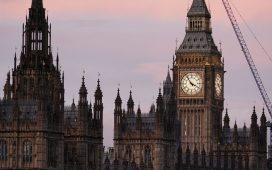More than 100 NHS trusts in England could be at or above full capacity this winter if they faced a second wave of coronavirus admissions on top of the usual seasonal workload, with figures suggesting that dozens would have 10% fewer beds than needed.
The Guardian compared each trust’s 2019/20 winter capacity against the number of beds they needed for Covid-19 patients in April, when an average of 16,000 beds were required for coronavirus patients per day, and May, by which time lockdown and physical distancing had reduced the number requiring hospitalisation.
The analysis carried out in collaboration with Edge Health suggested that if NHS England experienced April levels of Covid-19 pressure on top of normal winter pressures, 107 of 132 trusts (81%) would have fewer beds than were available to them last winter, with 46 trusts exceeding capacity by 110% or more.
But even if Covid pressures are closer to May’s lower levels, 79 of 132 trusts (60%) could reach capacity with seven trusts oversubscribed by at least 10% compared with last year.
Six trusts could be overwhelmed in either scenario, meaning that some NHS hospitals would struggle to accommodate all seriously ill patients needing admission.
The analysis excluded extra capacity provided through Nightingale hospitals or the private sector due to a lack of available data, and does not account for those who might have been reasonably expected to have been taken to hospital with or without a Covid-19 diagnosis.
An NHS England spokesman pointed to other measures, including its recently circulated third-phase Covid-19 plan, which contains a commitment to sustaining current NHS staffing, beds and capacity this winter. He highlighted an additional £3bn funding to allow for independent sector capacity, Nightingale hospitals and the safe discharge of patients from NHS hospitals through to March 2021.
“Over winter the NHS will flex hospital capacity and community services as needed, alongside a major winter flu immunisation campaign.
“While Covid inpatient numbers are currently low as we head into winter, the success of these efforts will of course also depend on controlling the virus in the community, including through test and trace, rapid action to control local outbreaks, and of course continued public support for hand hygiene and social distancing measures.”
However, the chief executive of NHS Providers, Chris Hopson, said: “These figures illustrate the point that trust leaders have strongly made over each of the last five winters – that there is insufficient acute bed capacity, and community capacity, to deal with winter demand.
“That’s not entirely surprising after a near decade of the longest and deepest funding squeeze in NHS history, when the NHS has been unable to grow its capacity to meet rising demand because it simply can’t afford to. We also know that our bed capacity is run at much higher levels of occupancy – often at 95% or higher – than in other comparable European countries.
Niall Dickson, chief executive of the NHS Confederation, which represents organisations across the healthcare sector, said: “We are worried and our members are worried. The NHS faces a collision of pressures this winter and this feels very much like the calm before the storm.
“It is not just the usual winter pressures, nor even just the very real concern about another spike which could disrupt efforts to restore services. The reality is that those delivering frontline services are having to work with significant infection control measures to contain the virus, including PPE and social distancing both of which reduce productivity. They are also having to cope with staff shortages and, frankly, there are some pretty exhausted clinical and support staff who have managed through this traumatic period.”
George Batchelor, co-founder of Edge Health, said: “As the NHS braces for a second wave of Covid-19 this winter it is critical that it does not again become a National Covid Service.”
The largest of the six trusts that would be overwhelmed, in either the modelled April or May scenarios, is King’s College Hospital NHS foundation trust in London.
King’s College London had an average of 1,444 (including adult critical care) beds open last winter, with an average of 1,427 of these occupied at any one point between December and February. This left a capacity of 17 beds on an average winter day – or just 1.1% of them available.
In April 442 beds of the hospital’s beds were occupied by coronavirus patients and 238 in May. If such numbers were to be replicated in a second wave on top of last year’s winter demand the trust would exceed capacity by 29.4% based on April demand and 15.3% on May demand.
Responding to the Guardian a spokeswoman for King’s College Hospital NHS foundation trust said: “Bed capacity management in a hospital setting is detailed and complex. These calculations over-simplify a much more nuanced picture.
“We have been using sophisticated modelling to plan for winter, forecast for a potential second surge in coronavirus patients, and manage the expected number of emergency patients.
“Our capacity planning includes repurposing wards and other clinical areas; working in collaboration with partners across south-east London, as we did during the peak of the pandemic, to ensure patients receive appropriate care for their needs; and reducing inpatients’ length of stay, including the repatriation of patients who have been referred to us for specialist care back to their local hospital.”
Five other trusts would be at least 10% overcapacity if they added either April or May’s coronavirus patients to last winter’s demand: Walsall Healthcare NHS trust, Countess of Chester hospital NHS foundation trust, East Cheshire NHS trust, Northampton general hospital NHS trust and Blackpool Teaching hospitals NHS foundation trust.
In response to requests for comment these trusts, all said they had developed or are developing plans for any surge of patients in the winter, including additional equipment, staff and critical care beds and pointed to collaboration with nearby hospitals or the private sector and the management of patients in their own homes.
While trusts were not overwhelmed at the height of lockdown, this was at the cost of the cancellation of a large number of routine appointments, scheduled operations and cancer referrals.














